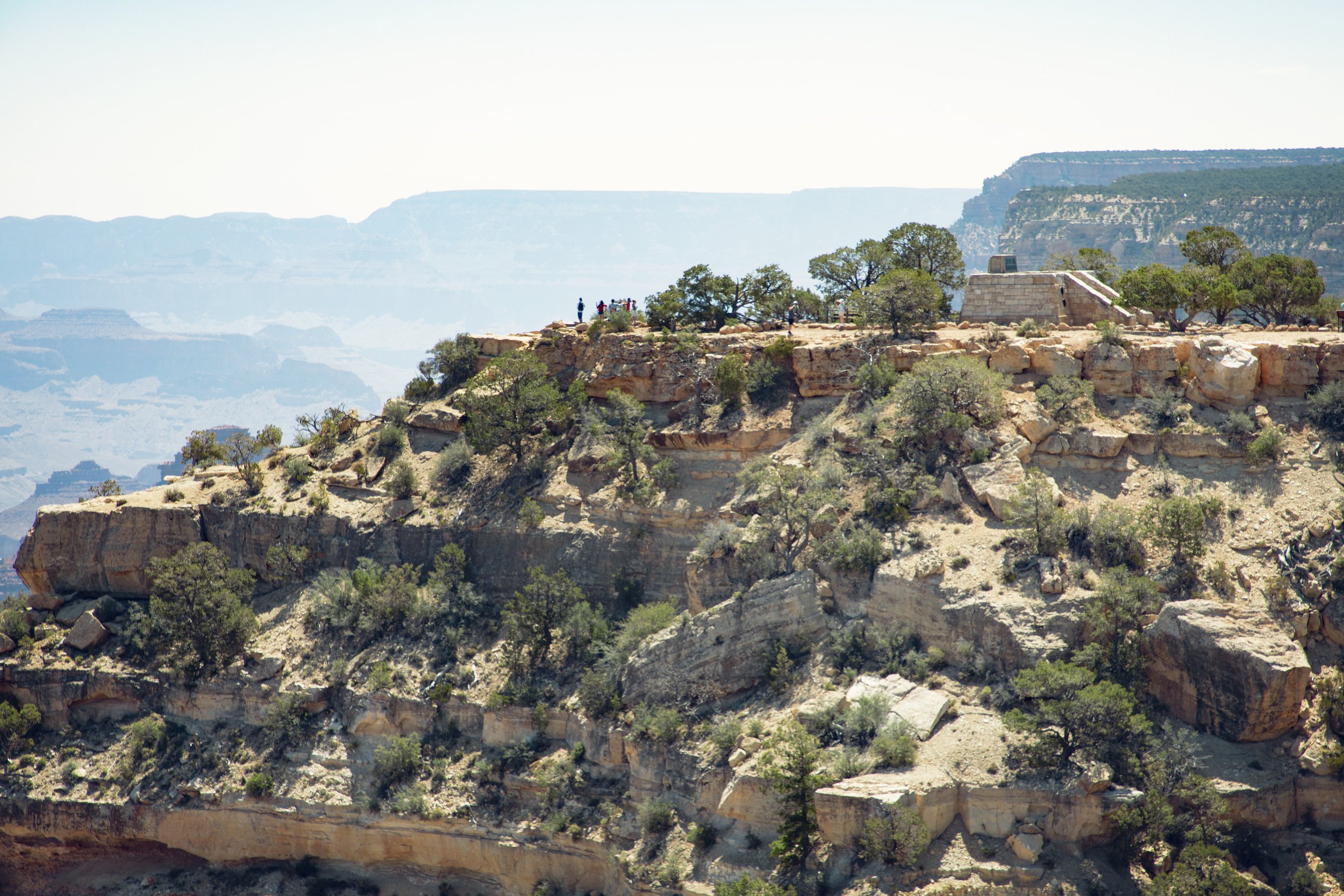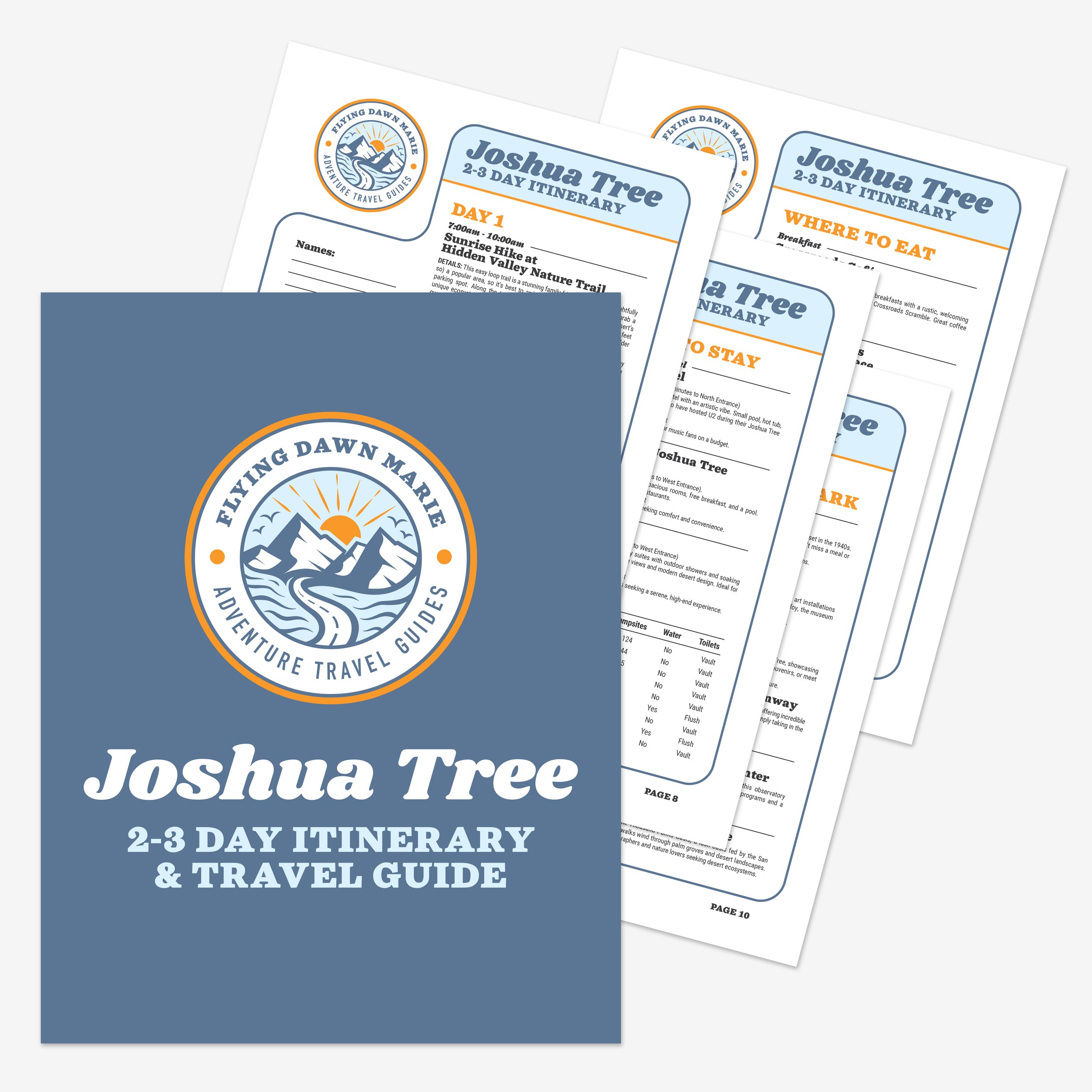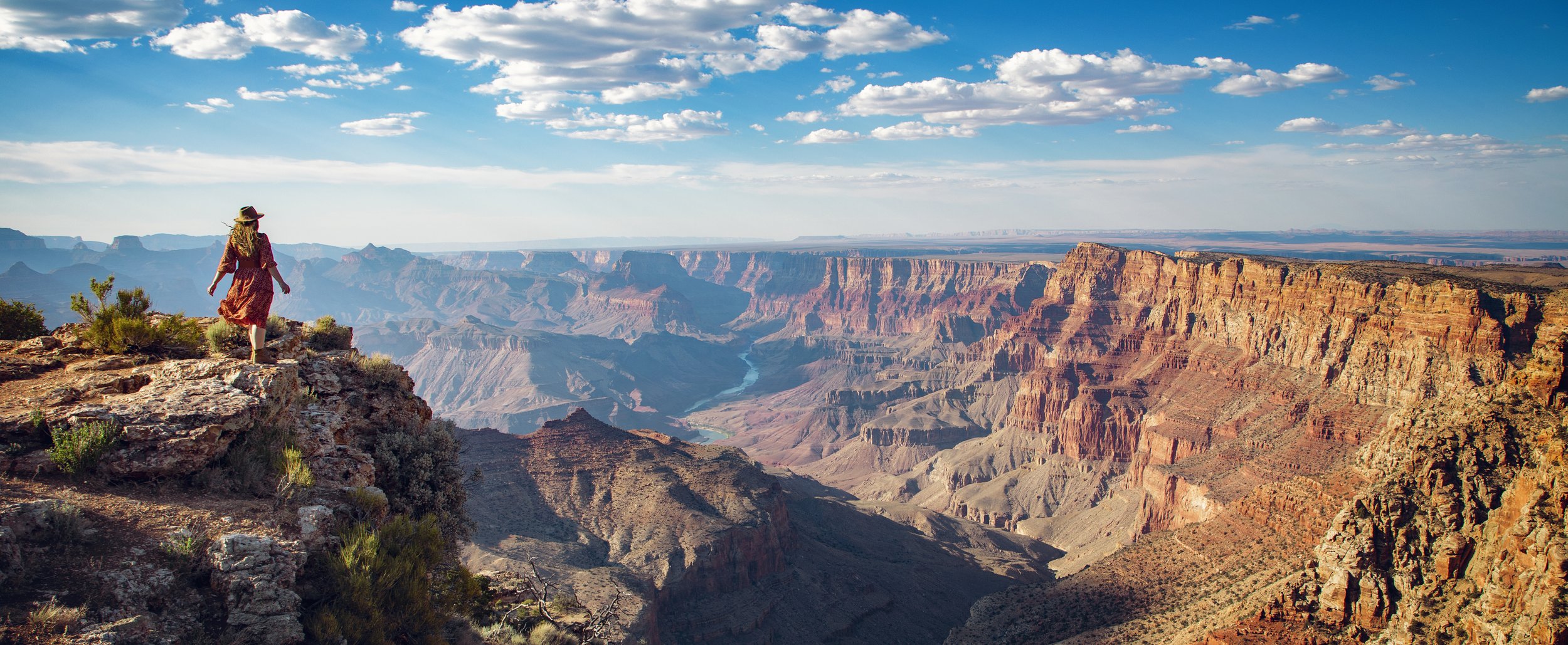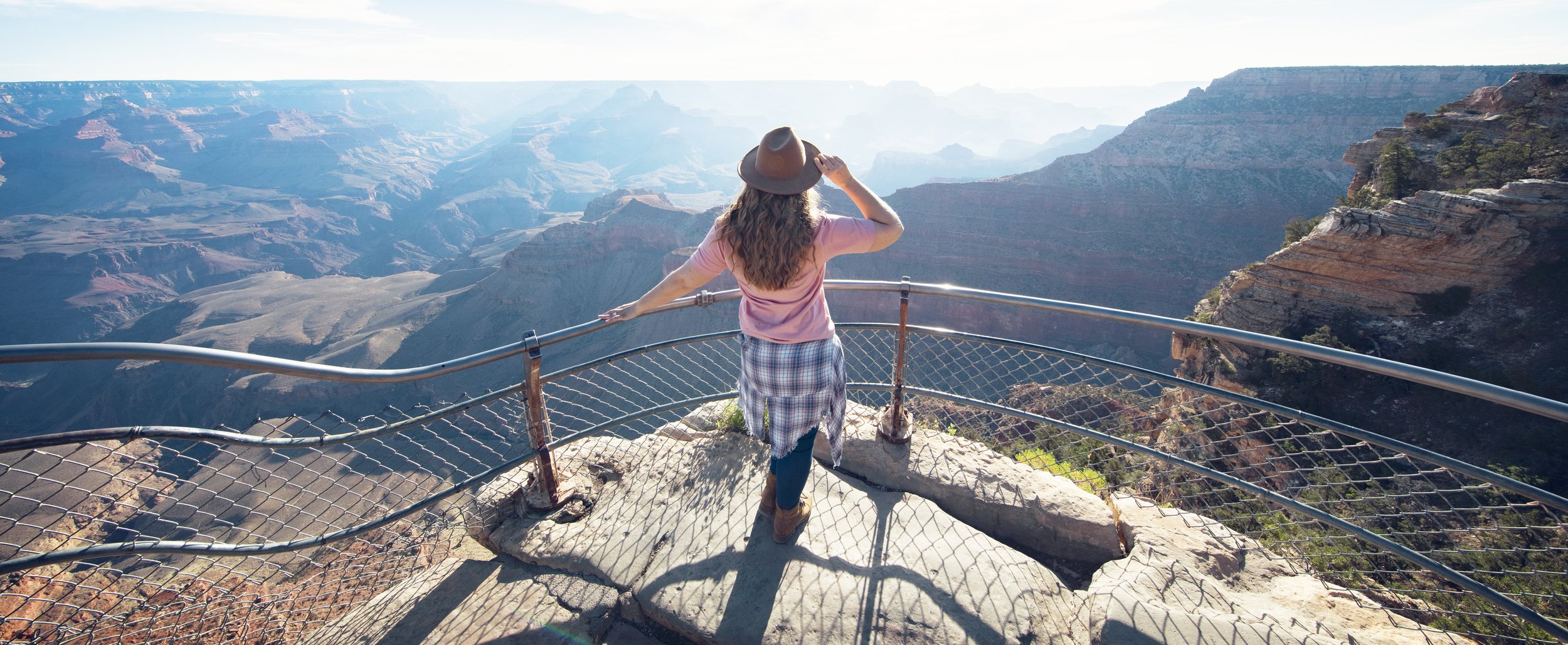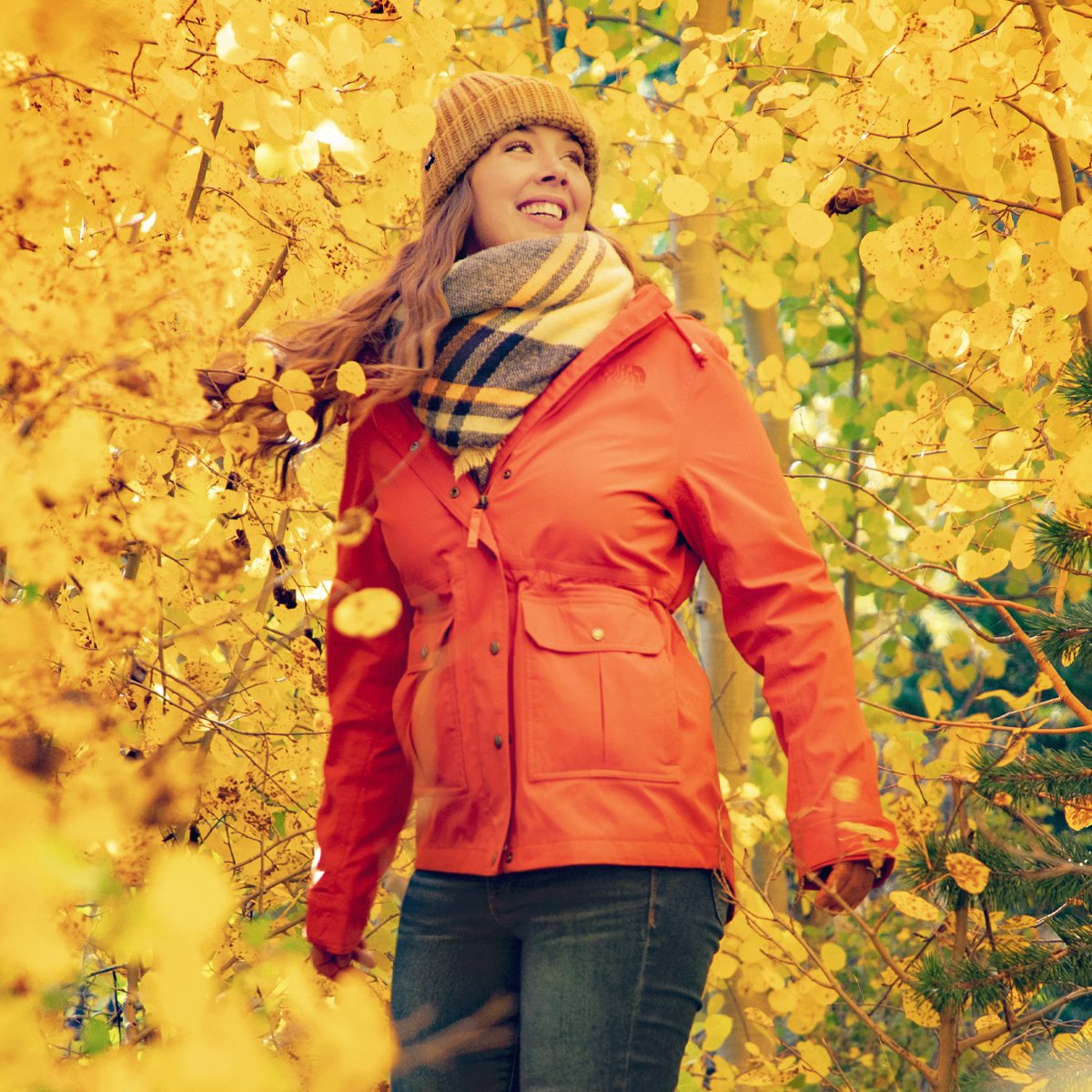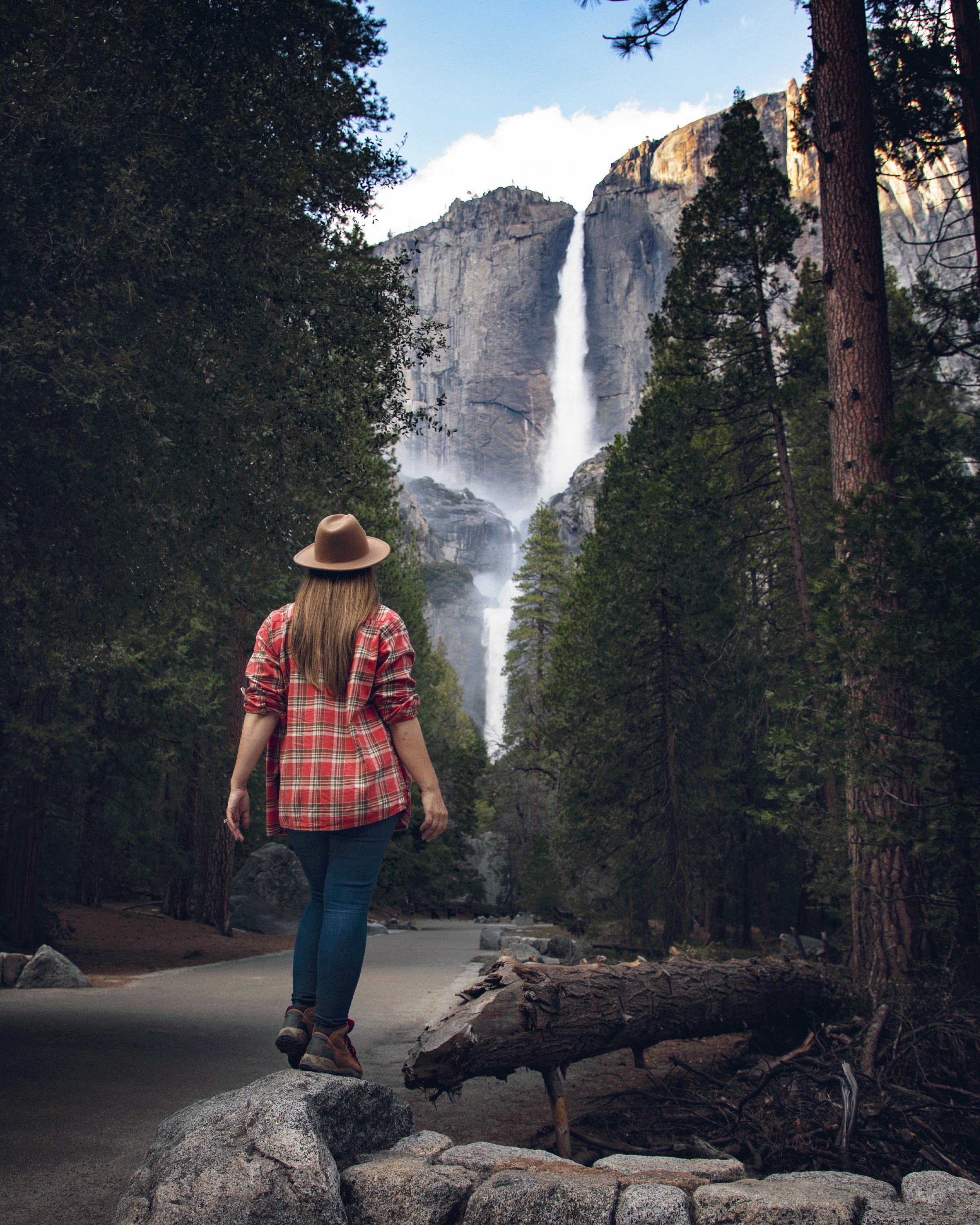Perfect 1-Day Grand Canyon Itinerary: South Rim Day Trip Guide
Hi friends! This week we’re exploring our nation’s 17th national park. The Grand Canyon’s South Rim is where most visitors get their first jaw-dropping look into the canyon’s mile-deep chasms and it’s been wowing visitors for over a century.
This 1-day Grand Canyon South Rim itinerary will pack in as many iconic views and experiences as possible – from a breathtaking sunrise at Mather Point to a sunset by the Desert View Watchtower. Along the way, we’ll ride the Hermit Road shuttle to discover the South Rim’s best viewpoints, enjoy lunch in the historic Grand Canyon Village, and take a scenic drive on Desert View Drive to explore its stunning stops. If you only have one day to enjoy the South Rim, this schedule is optimized for you. Join me below for this family-friendly, jam-packed journey in Grand Canyon National Park.
Views of the Colorado River from Hopi Point in Grand Canyon
Grand Canyon 2 Day South Rim Itinerary & Travel Guide
If you’re planning a multi-day road trip to Grand Canyon, make sure to download my complete Grand Canyon 2 Day Itinerary & Travel Guide, which includes an hour-by-hour schedule, Google & Apple map pin locations, the best sunset & stargazing spots, a complete dining guide, recommendations on where to stay, desert safety guide, and more!
Grand Canyon views from Trailview Overlook along Hermit Road
1 Day Itinerary at a Glance
This 1-day South Rim itinerary is designed to maximize each part of the day, catching the soft morning light from an east facing vista and the golden glow of sunset from a west facing viewpoint. We’ll start at daybreak near the Visitor Center, move west by shuttle in the morning, then drive east in the afternoon.
• Sunrise: Mather Point (plus a short Rim Trail stroll to Yavapai Point)
• Morning: Hermit Road shuttle tour with stops at Trailview Overlook, Powell Point, Hopi Point, Mohave Point, The Abyss, Monument Creek Vista, Pima Point, and Hermits Rest
• Midday: Lunch break in Grand Canyon Village (Village Historic District)
• Afternoon: Drive along Desert View Drive with stops at Pipe Creek Vista, Duck on a Rock, Grandview Point, Moran Point, Lipan Point, and Navajo Point.
• Sunset: Dinner and sunset at Desert View Watchtower
Before we dive in, a quick note: from roughly March through November, Hermit Road is closed to private vehicles, so you’ll be using the park’s free Hermit Road (Red Route) shuttle during the morning portion of today’s itinerary. Desert View Drive, on the other hand, is open to cars year-round. With that in mind, let’s get started!
Mather Point in Grand Canyon National Park
Stop 1: Mather Point
There’s no better way to kick off a Grand Canyon day than watching the sunrise paint the sky at Mather Point. Mather Point is often considered the best spot for sunrise in the park...and for good reason. As dawn breaks, you’ll see the canyon’s layered cliffs gradually illuminate in hues of gold, pink, and orange. The overlook juts out over the canyon, giving you incredible east facing views perfect for sunrise. It’s a popular spot (being just a 5-minute walk from the main Visitor Center parking), but in the early morning it’s often peaceful. I’ve found that just after the sun comes up, many photographers pack up and families haven’t yet arrived, making it a perfect moment to savor the serenity.
Yavapai Point in Grand Canyon National Park
Yavapai Geology Museum along Grand Canyon’s South Rim
Stop 2: Yavapai Point & Geology Museum
After enjoying the sunrise at Mather Point, we’ll take a leisurely stroll over to Yavapai Point, about half a mile further west along the Rim Trail. The paved path between Mather and Yavapai Points is mostly flat and offers constant rim-edge views. As we stroll, the expanding daylight reveals more and more of the canyon’s vastness. Yavapai Point itself is another spectacular viewpoint. I personally think it offers one of the best panoramic views along this section of the rim, and it’s often far less crowded than Mather Point. From here you can gaze deep into the canyon and spot features like Bright Angel Canyon and even a slice of the Colorado River winding below. Yavapai Point is also home to the Yavapai Geology Museum, which opens later in the morning (currently 8am according to the NPS website). If time allows, peek inside to see informative exhibits and huge windows overlooking the canyon. The museum building, built in 1928, was designed to blend into the surroundings using native stone and wood.
Pima Point along Hermit Road in Grand Canyon
Grand Canyon views from Hopi Point along Hermit Road
Powell Memorial and Powell Point along Grand Canyon’s South Rim
Stop 3: Hermit Road Shuttle
By the time you’ve soaked in Yavapai’s views, the sun will be up and the day truly begun. Now it’s time to hop on our next adventure: a shuttle ride heading west out along Hermit Road to see some of the South Rim’s best viewpoints!
From the Visitor Center parking area, head towards the Village area to catch the Hermit Road (Red) shuttle. You’ll need to take the free Village (Blue) shuttle or drive over to the Village shuttle transfer point (the Red Route begins at the Village Route Transfer stop, not at the Visitor Center). Once on board the Hermit Road shuttle, get ready for a scenic 7-mile ride with incredible overlooks at every turn. We’ll be hopping off at multiple stops to admire the views. The shuttles run frequently (every 10-15 minutes in the morning), so you can re-board the next bus when you’re ready to continue. The total drive time out to Hermit’s Rest and back is about 80 minutes, so that will gives us about 2 hours of total exploration time at the different stops. Below are the highlights from each stop, and although you truly can’t go wrong with any of these stops, I’ve marked an * next to the ones I wouldn’t miss :)
Trailview Overlook: Trailview offers a unique vantage point looking down on the famous Bright Angel Trail.
Maricopa Point: Get expansive unobstructed 180º views here, and look down on miles of the Tonto Trail traversing the canyon depths below.
Powell Point*: This overlook not only provides sweeping vistas, but also a stone monument honoring the explorer who led the first documented expedition through the Grand Canyon via the Colorado River in 1869 .
Hopi Point*: Hopi Point sits on a prominent bend of the rim, giving you commanding views both to the east and west – which is why it’s often cited as one of the best viewpoints for both sunrise and sunset.
Mohave Point*: Mohave Point has a slightly quieter feel and offers a dramatic perspective of the canyon with views of the Colorado River far below.
The Abyss: The Abyss overlook lets you peer down one of the steepest vertical drops on the South Rim – about 3,000 feet straight down to the canyon floor.
Monument Creek Vista: This viewpoint is named for Monument Creek (visible below) and offers a broad overlook into a side canyon.
Pima Point*: Pima Point is special for its acoustics. On calm days, this is the spot where you can hear the Colorado River.
Hermits Rest historic structure designed by Mary Colter
Bible verse plaque at Hermits Rest
Stop 4: Hermits Rest
Finally, the shuttle reaches Hermits Rest, the western terminus of Hermit Road (and of the Rim Trail). Hermits Rest is not just a viewpoint, but it’s also a historic site. It was named after a hermit/prospector Louis Boucher who lived in the area over a century ago. Here you’ll find a unique stone building designed by famed architect Mary Colter in 1914. Colter designed Hermits Rest to resemble an old miner’s cabin ruin, complete with a giant fireplace and a rustic archway entrance. Today, the cabin is a cozy gift shop and snack bar. This is a perfect place to take a breather – grab a drink or a quick snack (maybe a cup of coffee or lemonade), and check out the building’s interior with its vintage fireplace and historic plaque mounted outside. Restrooms are available here as well. Be sure to walk a few yards past the building to the actual Hermits Rest overlook – it offers a last look into the western expanse of the canyon. It’s a quieter vista, marking the end of the maintained viewpoints.
Enjoy a picnic lunch here or hop back on the shuttle for the ride back to Grand Canyon Village. The return shuttle from Hermits Rest will take about 30 minutes to the Village, with stops at only 3 of the viewpoints (Pima, Mojave & Powell), giving you one last chance to hop off and soak in the views if you’re doing well on time.
Bright Angel Trail seen from Trailview Overlook
Stop 5: Grand Canyon Village
Canyon Village is the bustling heart of the South Rim, and it’s the perfect place to take a mid-day break. Once you arrive back in the Village, you’ll find several dining options and historic buildings within walking distance. Be sure to refill your water bottles before leaving the village (water refill stations are available, as well as shops to buy bottled water or snacks). Hydration is key, especially if you’re visiting in the hot summer months. With lunch done and energy restored, let’s get back on the road for the next leg of our adventure: Desert View Drive!
Grand Canyon & Colorado River seen from Navajo Point
Grand Canyon & Colorado River seen from Lipan Point
Stop 6: Desert View Drive
Time to hit the road! The afternoon will be spent exploring the East Rim of the park via Desert View Drive (Highway 64). This 25-mile scenic road stretches from the Grand Canyon Visitor Center all the way to Desert View at the park’s east entrance. Unlike Hermit Road, this route allows private vehicles, so we’ll be driving ourselves and stopping at several overlooks along the way. Desert View Drive hugs the canyon’s edge for much of the way, offering unique and spectacular angles of the canyon and, eventually, views of the distant Painted Desert. We have a lot of ground to cover, so let’s get started eastbound. There are so many viewpoints with designated parking areas along Desert View Drive, but below are my favorites:
Pipe Creek Vista: This pullout will be on your left as you head east from the Visitor Center. Pipe Creek Vista is a quick and easy overlook to access – a small parking area with big views only steps from your car.
Duck on a Rock: There’s a small parking area here to pull over. This stop is named after a distinctive Kaibab limestone rock formation that, with a little imagination, looks just like a rubber ducky sitting on a rock ledge!
Grandview Point: To reach it, take the short spur road that leads to the Grandview parking lot (well-marked with signs). Grandview Point is aptly named – the views here truly are grand!
Moran Point: About 6 miles east of Grandview. Moran Point is named after Thomas Moran, a famous 19th-century painter whose dramatic paintings of the Grand Canyon (and other western landscapes) helped inspire the establishment of national parks.
Lipan Point: This is often a favorite overlook on Desert View Drive. Lipan Point sits on an elevated formation, facing west down the Colorado River and providing some of the most breathtaking views along this drive.
Navajo Point: The name is a tribute to the Navajo Nation whose reservation borders the park to the east. From Navajo Point, you can gaze down at the Colorado River and see the Desert View Watchtower perched on the cliffside to the east, our final stop of the day.
Desert View Watchtower seen from Navajo Point
Desert View Watchtower in Grand Canyon National Park
Stop 7: Desert View Watchtower
From Navajo Point, it’s a very short drive to our final stop of the day, Desert View. You’ll enter a large parking lot for the Desert View complex, which has the famous Desert View Watchtower, a museum, restrooms, a market & deli, and more. We’ve timed our day to reach Desert View about an hour or more before sunset, giving us time to explore and then relax for the evening show. Note that the market & deli here currently closes at 5pm (according the official website), so if you want to enjoy a meal here, you’ll need to arrive early or come prepared with a packed picnic.
Desert View is aptly named; as the sun sinks in the west, it will cast a glowing light onto the cliffs and create long dramatic shadows from the temples inside the canyon. The sky often ignites in orange, pink, and purple streaks. As dusk settles, the canyon slowly fades into a blue and purple haze and the first stars might pop out overhead. The Watchtower area is an awesome stargazing spot if you can stay after dark – far from city lights.
Duck on a Rock Viewpoint along Desert View Drive
Know Before You Go
• Start Early for Sunrise: Plan to enter the park early (before dawn) if you want that prime sunrise spot at Mather Point. The gates are open 24/7, and an early start helps you beat the crowds. Bring a flashlight or headlamp for walking in the pre-dawn darkness, and dress in layers – mornings can be chilly, even in summer, at 7,000+ feet elevation. Trust me, the canyon’s color show at sunrise is worth the early wake-up!
• Shuttle Logistics: If visiting March through November, remember that Hermit Road is shuttle-access only. The Red Route shuttle departs from the Village area, not the main Visitor Center. You can park near Bright Angel Lodge or take a connecting shuttle (Blue Route) from the Visitor Center to the Hermit Road Transfer Station. Shuttles run every 10-30 minutes; the entire Hermit route takes 80 minutes round-trip without hopping off. The last return bus leaves Hermits Rest about 30 minutes after sunset, so don’t get stranded out there after dark. In winter (Dec–Feb), when shuttles aren’t required, you can drive Hermit Road on your own – just check for snow closures. Check the official Grand Canyon NPS website for the most up-to-date shuttle information.
• Desert View Drive Tips: Desert View Drive is open to private vehicles year-round. It’s about 25 miles (40 km) from the Village to Desert View, so budget driving time accordingly, especially if you’re aiming for sunset. There are many viewpoints; we hit the main ones, but feel free to stop at others if time permits. Note that two viewpoints (Yaki Point and Shoshone Point) along this road require hiking or shuttles, and we skipped those in this one-day plan. Always park in designated areas and be cautious of traffic when pulling over.
• Stay Hydrated & Sun Safe: The high elevation and dry climate can dehydrate you quickly. Carry plenty of water for the day – at least 2 liters per person, more if it’s hot. There are water refill stations at the Visitor Center, lodges, and Desert View. Wear sunscreen, sunglasses, and a wide-brimmed hat. Even if it’s cool in the morning, the sun at altitude is strong. In summer, avoid excessive midday exertion – we’ve structured this itinerary with shuttle rides and short walks, but the sun can still be intense. Dehydration is the #1 issue for hikers here, so drink water often.
• Wildlife Awareness: The Grand Canyon is home to lots of wildlife. On any given day you might see elk, mule deer, big horn sheep, ravens, turkey vultures, California condors, ground squirrels, and even rattlesnakes or tarantulas (especially at dusk or in remote spots). Observe animals from a safe distance. Never feed wildlife – those cute squirrels can bite, and feeding them is harmful (plus illegal). Keep your food secure; the squirrels at popular viewpoints have been known to rummage through unattended bags! Also, watch for large animals on the roads when driving, particularly around dawn or after sunset.
• Safety at the Rim: Always be cautious near the canyon edges. Many viewpoints (like Mather, Hopi, etc.) have railings or defined viewing areas – stay within those for your safety. Some stops like Duck on a Rock or sections of Desert View have areas without guardrails, where you can walk out on rock ledges. If you do, use common sense and don’t go out if you’re uncomfortable with heights. Keep an eye on children at all times; a beautiful view can be distracting, so hand-holding near edges is wise. And please, do not toss rocks or coins over the edge – apart from being litter, it can be deadly for wildlife...sadly, a condor died after swallowing coins thrown from Mather Point. Let’s keep the canyon wild and safe.
• Amenities & Facilities: Restrooms are available at major points like the Visitor Center, Yavapai Point (near the museum), Hopi Point, Hermits Rest, Grand Canyon Village (various spots), and Desert View. Plan pit stops accordingly. There is a gas station at Desert View and one in the Village (near Market Plaza), which is good to know if you’re running low on fuel by day’s end.
• Minimal Cell Service: Be prepared for minimal cell service in Grand Canyon National Park and come equipped with a GPS enabled device. You might get signal in the Village and at Desert View, but expect little to no service along Hermit Road and some stretches of Desert View Drive. Download or carry maps/directions. I highly recommend pre-downloading maps of the area for offline use on the Gaia GPS app for iPhone & Android devices. Download it today at GaiaGPS.com and get 10% off!
• Weather & Seasons: This itinerary is doable year-round, but each season has considerations. In winter, the days are much shorter, so the itinerary will need to be condensed a bit, potentially with less stops at viewpoints. Also, parts of the rim can be icy or snowy (carry traction devices for walking if needed), and Hermit Road will be open to cars (less crowds, but check road conditions). Spring and fall have milder temperatures – great for doing everything on the list, just bring a jacket for cool mornings. Summer brings hot temperatures and afternoon thunderstorms (the monsoon) in July/August. Keep an eye on weather forecasts as storms can develop quickly. If thunder roars, go indoors (lightning strikes are a real danger on exposed viewpoints). Always have a little flexibility in your plan in case of unexpected weather.
• Reservations & Fees: Remember that Grand Canyon NP requires an entrance fee ($35 per vehicle for a week), or you can enter with your America the Beautiful Pass. No reservations are needed to enter the South Rim. However, lodging and some dining in the park often require reservations well in advance, so plan those ahead if you’re staying overnight or want a special meal at El Tovar. The shuttles are free and first-come, first-served – just line up at the stops.
• Capture the Memories: You’ll definitely want to take photos at all these amazing places, but don’t forget to also soak it in with your own eyes. The views are truly something a camera can’t fully capture. If you’re into photography, sunrise at Mather and sunset at Desert View are prime golden hour moments – a tripod can be handy. And if you’re staying late, Grand Canyon is an International Dark Sky Park, so astrophotography is spectacular. Just remember to be courteous to others enjoying the dark and avoid shining bright lights unnecessarily.
Downloadable Itineraries & Travel Guides
Turkey vulture soaring over the Grand Canyon
In Summary
Thanks so much for joining me this week inside Grand Canyon National Park. For a virtual visit of this epic 1-day South Rim itinerary, make sure to watch my Behind the Blog video located at the top of this post, or watch it on YouTube here. Until next week, I hope you find adventure and encouragement wherever you go.
Yavapai Point in Grand Canyon National Park
If you enjoyed this post, you might also like…
About Me
I’m Dawn Marie, a travel and lifestyle blogger based out of Southern California. With in-depth articles, travel guides, and reviews on hotels & products, I seek to share my journeys to help you plan for your own. My adventures take me all over California, the western United States, and around the globe...and every Monday I post new content here, including a comprehensive blog post and YouTube video.
Search the Blog
Featured Posts
Etsy Shop









